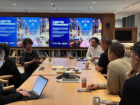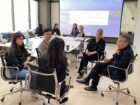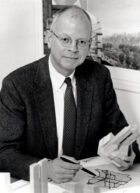In 2021, a group of designers at SOM founded the Asian Alliance to elevate the visibility of the Asian Pacific community within our offices and more broadly in the AEC industry. Since that time, the Asian Alliance has been a vital resource for connection, support, and professional development for more than 200 members firmwide.
In recognition of Asian American and Pacific Islander Heritage Month, we spoke with four leaders who have been instrumental in the formation and evolution of the Asian Alliance—Partner Leo Chow, Associate Principal Andy Rah, and current Asian Alliance leaders John Hernandez and Jacqueline Li—to discuss the group’s approach to fostering cultural dialogue and their hopes for the future.
The Asian Alliance was formed at the height of the COVID-19 pandemic. What motivated you to create this group?
Andy Rah: There was a wave of anti-Asian hate crimes at the time, and many of us felt vulnerable. We recognized a deep need to support our Asian American, Native Hawaiian, and Pacific Islander American (AANHPI) colleagues—to raise awareness of these issues while also addressing the greatest challenge that we’ve faced internally, which is upward mobility into leadership positions. We wanted to build more confidence among our Asian colleagues, and the way to do that was to foster greater inclusivity, provide mentorship, and create a platform for our voices to be heard.
Jacqueline Li: The events that were happening really demonstrated a need to form a community, and because we were working remotely, we missed the collective atmosphere of the office. This became a catalyst to get people on Zoom and have a conversation. We realized how many of us were thinking about the same things—about safety, about advancement into leadership roles, about having a voice—and that’s when we decided to create an employee resource group (ERG).

What are the ways you fulfilled that original mission?
Jacqueline: We held a lot of listening sessions to identify our community’s needs. Several ideas came out of that, including SOM Voices—a platform for younger designers to present their interests and backgrounds—and mentorship programs. Much of that mentorship has focused on the performance review process and providing our colleagues with strategies for success.
John Hernandez: One of the questions we also asked ourselves was: what does it mean to truly build a community? We felt that the best way to do that was by helping our colleagues feel comfortable bringing their full selves to work. To do that, we had to raise awareness of AANHPI cultures and recognize the multitude of subcultures within this group. It’s a simple idea, and it’s made a profound impact. We started with Lunar New Year celebrations and expanded to include Eid for our Muslim colleagues, Diwali for our South Asian colleagues, and the Mid-Autumn Festival, and also observe Filipino American History Month. Each of these events give our colleagues the opportunity to celebrate their cultures with others outside their home, and expose everyone in our offices to these cultures.


How does the SOM partnership support the Asian Alliance?
Leo Chow: All of our ERGs are important in a similar way. They give our employees the ability to have conversations about the issues they face through a cultural lens and to share their experiences across all our offices. I’ve always valued the grassroots approach of the Asian Alliance and the other ERGs, and it’s our responsibility as partners to support them. We do that by recognizing their voices, to make sure every group feels comfortable speaking up, and also by allocating both time and money to host celebrations, talks, and other activities throughout the year. For the Asian Alliance, we’ve been able to support pro bono work in local communities around our offices.

Tell us about that project work.
John: We take on projects that resonate with our values. In Los Angeles, we entered a competition in 2022, alongside more than 150 designers, to create a memorial for the 1871 Chinese Massacre—a relatively little-known episode in the city’s history. The memorial was an effort by the city to reconcile with the past, and this aligned with our mission to increase visibility of the Asian American experience. An artist won that competition, but the experience was quite significant. There’s something special about devoting our time and expertise to a meaningful cultural landmark.
Andy: We had also been doing research around that time on Chinatowns across the United States, learning about their development and the role they play in creating a diverse city. We invited Joanne Kwong, who runs Pearl River Mart, an iconic local business in New York City, to speak with us. Shortly after that, she reached out and asked if we’d be interested in helping with an initiative called Light Up Chinatown. It was a feasibility study to improve both the safety and character of Chinatown’s streets by determining where lighting is needed most. We were able to build upon the research we’d already done, and it was exciting to be able to contribute our skills as designers to a community in need.

In addition to Kwong, the Asian Alliance often brings in speakers from outside the design profession. Why is it important to hear from leaders in other fields?
Andy: There’s so much we can learn from Asian professionals in other industries. They’ve navigated many of the same challenges that we face. In 2021, we invited Bing Chen from Gold House, a nonprofit organization that advocates for greater representation of the Asian community in the cultural and media sphere, to talk to us about his work.
What we learned from Bing was how to champion for others, because the success of one leads to the success of many. It’s inspired us at Asian Alliance to be more thoughtful in our programming, and to focus on where we can create the greatest impact for our diverse, multicultural group.
This year’s theme for AAPI Heritage Month is “Common Ground.” How did you arrive at that idea?
Jacqueline: We want everyone to provide input—having a voice is what this is all about—and so we had a big brainstorming session. Two main ideas emerged from that: a desire to celebrate each unique culture within the Asian community and to strengthen our connection with one another. We’re individuals from diverse backgrounds, but we all face similar issues. The idea behind “Common Ground” is that we can embrace our individuality while identifying the experiences that we all share.
We’ve held three events this month to recognize that theme. It kicked off with a lecture from Preeti Sriratana, the Founding Partner of the design firm Modellus Novus, who spoke to us about building spaces that reflect and shape culture, and how to identify opportunities to design equitably. Several young architects presented their stories and inspiration as designers as part of our latest “SOM Voices” forum, and this week, a roundtable with several colleagues across our offices investigated how SOM navigates the intersection of place, local identity, and contemporary design in Asia.


At a time when many companies are turning away from DEI efforts, why is it important to maintain a strong position?
Leo: We need to give our staff the chance to lead a cause that they feel personally invested in. This group is passionate about creating a dialogue and making SOM a better place to work. It’s our responsibility as a firm to respond to that and support it. And for an international firm like ours—with projects in dozens of countries around the world—it’s important that we have a diversity in thought and life experience among our staff and that we help people from all backgrounds grow in their careers.
John: Helping our colleagues grow ultimately bolsters our design practice. One of the initiatives that we’re working on is to strengthen the connection between employees and managers—to make sure your manager really understands you and will vouch for you. This idea came to our attention through a talk we hosted with Jackie Wong, a former architect at SOM who now works at the management consulting firm McKinsey. He presented his report about Asian Americans in the workplace, which found that Asian workers have received less attention when it comes to promotions, usually because of a cultural barrier.
Our role in the Asian Alliance is to break down that barrier. There’s no particular science behind how to reach that goal, but we can start by spreading awareness of all the cultures that we represent. We have also hosted workshops around our annual mid-year reviews and performance reviews, with the goal of helping our colleagues foster a more organic connection with their managers.

What are your hopes for future generations of Asian architects?
John: My hope is that our work instills a greater empathy and understanding for people of all backgrounds. America is this big melting pot of cultures, and SOM reflects that diversity. Everyone deserves to feel seen, and to feel like they belong.
Leo: When I started working at SOM in 1990, I was really inspired by the cultural backgrounds of our three studio heads in San Francisco: an Asian man, a white man, and an African American woman. They brought such a diversity in perspective to the work we were doing and that made it a really compelling setting. Fostering that kind of exchange across our studios continues to be an important goal. It’s part of the mission of our Equity Action Committee. The events that the Asian Alliance hosts—sometimes in collaboration with other groups such as the Women’s Initiative or National Organization of Minority Architects (NOMA)—are for everyone in the firm. I think that’s a very powerful idea, and I look forward to seeing this group continue to collaborate in that way.
Jacqueline: I’d like to keep inspiring our colleagues to feel empowered to speak up and have their voices heard. No one should ever feel as though they can’t make a change. We have a significant number of Asian staff, but there’s still a lot of work to be done to support career growth. Creating the roadmap to help our colleagues feel comfortable and, ultimately, advance into leadership positions is at the top of that list.
Andy: Embracing our identities makes us better designers. Our creativity is informed by our cultures and life experiences, and we want to keep finding ways to contribute to our local neighborhoods and cities around the world. The work that we’re doing with the Asian Alliance is setting that foundation.





